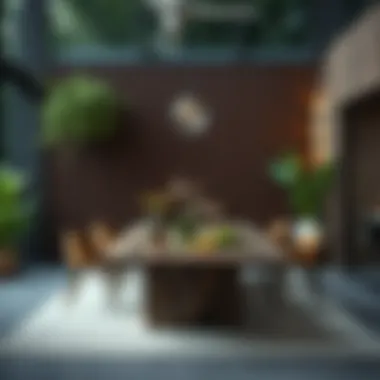Exploring the Terrain Dining Table: Nature Meets Design


Intro
In recent years, the phrase "bringing the outdoors in" has gained quite a following among homeowners and designers alike. However, translating this notion into your dining experience goes beyond just a decorative touch here and there. It’s about embracing nature through functional design. Enter the terrain dining table, a stunning piece that embraces raw, organic materials and incorporates them seamlessly into your living environment. This exploration dives into the key elements that make terrain dining tables unique, alongside their impact on both aesthetics and functionality.
As we navigate through the essential components such as design inspiration, materials used, and practical styling tips, it becomes clear why these tables have rocketed to popularity. They serve as not just furniture, but as conversation starters, grounding us back to nature while accommodating our modern lives. Whether you're an interior design enthusiast, a passionate host, or just someone wanting to elevate their dining space, the insights here will guide you in making informed decisions regarding terrain dining tables and their place in your home.
Let’s embark on this journey where craftsmanship meets mother nature in a harmonious blend.
Understanding Terrain Dining Tables
The terrain dining table represents not just furniture but an intersection between nature and artistry. In this section, we delve into the essentials of these tables, emphasizing why they have gained popularity in modern home design. The key elements include their blend of natural materials, unique aesthetics, and adaptability to various interior designs.
Definition and Concept
A terrain dining table can be defined as a piece of furniture that showcases organic materials and textures often found in nature. Unlike traditional dining tables, which may emphasize symmetry and uniformity, terrain tables often reflect the irregular beauty of the natural world. This can incorporate raw wood finishes, stones with varying patterns, and even elements like metal that echo natural shapes. As a result, each table becomes a distinct piece, imbuing a sense of individuality into your dining space.
Having a terrain dining table means embracing variations and imperfections. An example might include a table constructed from reclaimed barn wood, complete with its unique knots and worn edges, which tells a story of its past life. This organic quality allows homeowners to appreciate uniqueness, creating an ambiance of warmth and sophistication in both casual family dinners and more elaborate dining experiences.
Historical Context
The roots of terrain dining tables can be traced back to the mid-20th century, where the rise of the organic design movement began to take shape. Designers like Hans Wegner and George Nakashima emphasized craftsmanship and connection to nature. Their influence brought about a more profound appreciation for materials that weren’t just functional but were also visually appealing.
In contrast to the more industrial and polished furniture styles that dominated post-World War II, the naturalistic approach of terrain tables started to resonate with a growing audience. As people spend more time indoors, the desire to incorporate outdoor elements into their homes has surged. The movement toward sustainability and eco-conscious design practices further accelerated the popularity of these tables, leading to a growing preference for items that celebrate natural imperfections and the inherent beauty of materials.
This evolving perspective has encouraged many designers today to explore local materials and traditional crafting techniques, creating a circular economy that not only provides aesthetic value but also supports local artisans. The dialogue between the environment and design is more relevant than ever and echoes the historical journey of terrain tables.
Design Elements of Terrain Tables
The significance of design elements in terrain dining tables cannot be overstated. These aspects not only define the aesthetic appeal of the tables but also enhance the functionality and durability of the pieces. By paying careful attention to the materials, textures, colors, and forms used, one can create a space that reflects individuality while harmonizing with nature. Each component plays a crucial role in ensuring the harmony between practicality and visual delight.
Incorporation of Natural Materials
Natural materials are at the heart of what makes terrain dining tables a unique offering. Their presence introduces an organic touch that resonates with the essence of nature, offering a refreshing contrast to modern materials.
Wood Varieties
Wood varieties contribute significantly to the overall aesthetic and durability of terrain tables. One notable feature of wood is its varied grain patterns. For instance, oak, walnut, and teak not only bring distinct textures to the table but also possess natural resistance to wear and tear. This makes hardwood a popular choice for those seeking longevity in their dining furniture.
A prime advantage of wood is its ability to be refinished, allowing for maintained beauty over the years. However, one drawback could be its susceptibility to scratching or denting, thus requiring proper care and maintenance for preserving that pristine look.
Stone Usage
Stone usage adds a robust charm and design integrity to terrain tables. Materials such as slate or granite can be an elegant addition to these tables, providing a unique, cool surface that stands out visually. The key feature of stone is its uniqueness—no two slabs are the same, ensuring that each table is truly one of a kind.
While durable, stone is also heavy, which might complicate the movement of the table. Additionally, depending on the finish, some stones may be prone to staining if not properly sealed, which is a consideration for any homeowner.
Mixed Medium Approaches
Mixing different materials has gained popularity in terrain dining table design. A mixed medium approach often involves pairing wood with metal or stone, creating a dynamic interplay of textures and materials. The key characteristic here is the contrasts and complements that arise from the fusion.
By using metal legs with a wooden tabletop, for example, one can achieve a modern yet rustic feel. This versatility can appeal to a broad range of interior styles. However, the challenge is ensuring that the materials chosen work well together in terms of aesthetics and maintenance requirements.
Aesthetic Considerations
The aesthetic implications of terrain dining tables play a pivotal role in interior design. The colors, textures, and forms of these tables can influence the dining environment profoundly.


Color Palettes
When selecting color palettes for terrain dining tables, one finds that earthy hues tend to dominate, reflecting the beauty of nature. Warm tones such as browns, greens, and deep blues not only resonate with organic themes but also make a space feel more inviting.
What’s essential about these palettes is their ability to blend seamlessly with various décor styles, thus allowing for versatility in interior design. On the downside, relying on darker colors may require more meticulous cleaning, particularly if the table is used frequently.
Texture Combinations
Texture plays a pivotal role in elevating the visual appeal of terrain tables. Layering different textures, such as smooth wood with a rough stone, can create a striking visual impact. The varying tactile sensations can positively enhance the dining experience.
However, one must be cautious as excessive texture contrast could result in a chaotic appearance. Striking the right balance ensures that the textures complement rather than compete with each other.
Form and Function
The form of terrain dining tables greatly influences their usability. Whether it’s a long rectangular table for gatherings or a round one for smaller spaces, the functionality should always align with its design. A well-thought-out form not only serves the need for dining but also contributes to the room’s overall flow.
One of the advantages of designs that prioritize function is their adaptability, making them suitable for both casual family meals and more formal gatherings. However, intricate designs can sometimes limit movement around the table, which is an important consideration for hosts when designing dining areas.
The Versatility of Terrain Dining Tables
The allure of terrain dining tables lies not only in their aesthetic beauty but also in their remarkable versatility. These unique pieces blend seamlessly with a multitude of design philosophies and serve a wide range of functions within the home. The capacity of these tables to adapt boosts their desirability among homeowners, interior design enthusiasts, and even event hosts. Their sturdy construction and natural materials allow them to shine in various environments, making them a solid choice for anyone looking to enhance their spaces.
This versatility can be split into foundational elements: adapting to various styles and accommodating different settings. Let’s delve deeper into these aspects to illustrate how terrain dining tables can cater to diverse tastes and functions.
Adapting to Various Styles
Modern Minimalism
Modern minimalism emphasizes simplicity and clean lines, often opting for a less-is-more approach. A terrain dining table in this style might feature sleek, unadorned surfaces, crafted from a single wood type, potentially maple or oak, allowing the natural grain to be the artwork itself. This characteristic contributes to an uncluttered and airy space, perfect for individuals who appreciate the elegance of understated aesthetics.
The practical side of modern minimalism is quite appealing too; the straightforward design makes maintenance a breeze, as dust and food crumbs don’t have many crevices to hide in. However, too much minimalism may come off as stark for some, lacking warmth. Striking a balance by incorporating textiles or subtle decor can remedy this.
Rustic Charm
Rustic charm is all about comfort and a welcoming atmosphere. Terrain tables designed with this style often use reclaimed wood or detailed finishes that highlight their imperfections. Think of deep woods like walnut or pine, showing their character through knots and variation in color, aiming to create a cozy and lived-in feel. This style resonates with those who enjoy a sense of history and authenticity in their furnishings.
One of the strong suits of rustic charm is its ability to foster connection. When gathered around a beautifully distressed table, there's an intimacy created that’s hard to replicate. On the flip side, the rugged nature of rustic design can sometimes clash with more modern homes, making it crucial to thoughtfully blend these elements for harmony.
Industrial Flair
Industrial flair draws inspiration from repurposed spaces, bringing an edge to the sleek lines of urban living. A terrain dining table in this category may incorporate metal bases and rough-hewn wooden tops, emphasizing a raw yet polished aesthetic. This choice often suits individuals who value innovative and bold design choices.
The unique feature here is the interplay between materials – the contrast between cold metal and warm wood creates a fascinating dynamic that stimulates the senses. However, one must consider the weight of the industrial vibe; if not balanced right, it can overpower a space, making it feel more like a workshop than a home. Incorporation of softer elements, such as textiles or greenery, can mitigate this.
Use in Different Settings
Indoor Dining Spaces
Using terrain dining tables in indoor settings is perhaps the most traditional application. They serve as focal points in dining areas, encouraging gatherings and connections over meals. A key characteristic here is the ability to harmonize with a plethora of decor styles, whether you're going for an elegant, understated look or vibrant and eclectic.
One of the primary benefits is the enhanced ambiance they can generate in a room. When hosting dinner parties, these tables can adapt to fit the occasion, making them not just furniture but essential parts of the experience. However, the static nature of indoor installations can lead to monotony if not occasionally refreshed with decor.
Patios and Outdoor Areas
Terrain dining tables shine exceptionally well in outdoor settings, accommodating alfresco dining experiences. The durable nature of the materials often lends them to withstand various weather conditions, making them an integral part of outdoor entertaining.


Here, the characteristic of being swim-friendly with outdoor décor adds value to these tables, allowing for seamless transitions from formal to casual gatherings. However, one must factor in the need for protection from elements like rain and sunlight, which can warp the wood or fade finishes over time.
Event Hosting and Gatherings
Event hosting is another arena where terrain dining tables wield significant versatility. They can cater to everything from laid-back barbecues to elegant dinner parties. In this context, the key characteristic lies in their capacity to accommodate different arrangements and seating styles, making sure your guests feel comfortable and included.
A unique feature here is the ability to dress them up or down, depending on the event’s theme. Unfortunately, the versatility that comes with accommodating various setups may sometimes lead to logistical challenges, particularly with larger guest lists or space constraints. Planning becomes essential to maximize utility while enhancing the aesthetic.
Through their adaptability, terrain dining tables become more than mere furniture. They transition according to needs, styles, and settings, reinforcing their status as indispensable pieces in the modern home.
Maintenance and Care for Terrain Tables
Taking care of terrain dining tables is not just about aesthetics. It’s about preserving the elegance of nature's artistry that resides within these unique pieces. As these tables often blend wood, stone, and various natural elements, maintenance feels much like tending to a garden. Proper care ensures they remain functional and beautiful, allowing one's home to reflect that harmony between nature and design in the long run.
Routine Cleaning Tips
Keeping a terrain dining table clean requires a gentle touch and a thoughtful approach. Here are some key recommendations:
- Dust Regularly: Use a soft, lint-free cloth. Dust settles on surfaces, and it’s best to avoid it accumulating over time.
- Mild Soap Solution: If the table needs a deeper clean, a solution of warm water and mild soap can work wonders. Avoid harsh chemicals that might strip the natural finish.
- Avoid Excess Moisture: Natural materials can warp or be damaged by water. Wipe spills immediately, and if you use a damp cloth, ensure it's not soaking wet.
Enhancing Dining Experiences with Terrain Tables
The presence of a terrain dining table in one’s home is more than just an addition of furniture; it’s the heart of gatherings and a stage for culinary arts. This section digs into how these tables enhance dining experiences by bridging functionality with aesthetic charm, making every meal something remarkable.
Table Settings and Decor
Selecting the Right Dinnerware
Choosing dinnerware goes beyond just matching colors or styles; it’s about creating harmony with the table itself. The right dinnerware complements the natural beauty of terrain tables, typically characterized by their raw finishes and organic forms. Opting for ceramic or wooden dinnerware introduces an earthy vibe that resonates with the table's intrinsic ethos. This approach presents a very beneficial choice, as it brings forth a unison that feels both warm and inviting.
"Dinnerware selection can truly elevate the dining experience. It's like wearing the right outfit for a grand occasion.”
Unique features of selecting the right dinnerware include the potential to experiment with textures — think minimalist pieces against rugged, unfinished surfaces. While mixing patterns might seem appealing, it can also distract or clash with the serene essence that a terrain table offers.
Centerpiece Ideas
Centerpieces serve as focal points that draw the eye and spark conversation. Incorporating natural elements, like a bouquet of wildflowers or a rustic wooden bowl filled with seasonal fruits, can elevate the terrain table's charm. Using organic materials aligns perfectly with the table’s design, creating a cohesive theme that celebrates nature in a thoughtful way. Centerpieces can also change with the seasons, presenting an opportunity to refresh the table setting throughout the year.
However, while larger centerpieces can be eye-catching, they may inhibit conversation or the guests’ ability to interact comfortably. Hence, keeping it balanced in scale is crucial.
Lighting Considerations
Lighting plays a pivotal role in setting the ambiance around terrain dining tables. Warm, soft lights or strategically placed candles create an inviting atmosphere, encouraging lingering conversations over dinner. Hanging lights or pendant lamps that cast gentle illumination can highlight the table without overpowering the natural beauty of the wood or stone.
One of the unique features of thoughtful lighting is that it can be easily altered for mood; brighter lights for lively gatherings, and dimmable options for a romantic dinner. The downside comes into play with flashy or harsh lights, which can detract from the natural experience that terrain tables evoke.
Creating Atmosphere
Seasonal Decor Tips
Seasonal decor is a lovely way to keep the dining environment fresh and lively. Whether it's placing autumn leaves or twinkling fairy lights for winter festivities, decorating according to the season offers many opportunities for creativity. Not only does it keep your table looking current, but it also provides guests with a taste of everything nature has to offer throughout the year.
The beauty of seasonal decor lies in its adaptability. Elements can be swapped or transformed easily to fit the mood of the occasion — while some may argue it could feel a bit overdone if too much is added, tasteful and minimal updates can enhance the experience rather than overwhelm.
Theme-Based Events


Theme-based events allow homeowners to express their creativity and personality through dining experiences. Hosting a casual outdoor brunch with a vibrant floral theme or a more refined, monochrome dinner party can showcase the terrain table in distinctly different lights. Themes provide a unique framework for decor, allowing for cohesive planning that draws people together under a shared experience.
The challenge here is ensuring *the theme does not overshadow the meal. Intricate setups can distract from the dining experience if not managed carefully, so balance is key. Additionally, it invites guests into a world of imagination, which can create lasting memories that linger long after the meal is over.
By utilizing these elements, terrain tables transform ordinary meals into extraordinary experiences. Careful consideration of each aspect ensures a sophisticated harmony that celebrates natural beauty while enhancing social interactions.
Buying Considerations for Terrain Dining Tables
When it comes to buying a terrain dining table, several elements make the experience both engaging and essential for homeowners and design enthusiasts alike. It's not just about selecting a piece that looks good; it's about finding one that fits seamlessly into your living space while reflecting your personal style and values.
Assessing Size and Scale
Finding the right size for your terrain dining table is crucial. You want a table that complements the room without overwhelming it. First, you'll need to measure the space where the table will reside. Take into account existing furniture like chairs, sideboards, and any other features that might impede movement. A good rule of thumb is to leave a minimum of three feet around the table for comfortable passage.
- Size matters: You want a table that fits your family size and the typical number of guests you entertain. A six-person table might suit you well if you love hosting.
- Shape plays a role: Round tables may fit snugly in small areas, allowing for easier flow, while rectangular tables could work well in longer rooms.
In short, finding the appropriate size and scale is crucial for functionality and visual appeal.
Evaluating Quality and Craftsmanship
When investing in a terrain dining table, quality and craftsmanship should never take a back seat. There’s a world of difference between a mass-produced piece and one that brings handcraftsmanship into play. Look for tables made from solid wood or sustainable materials, as these not only add durability but also a unique character to your dining area.
- Joinery techniques: Mortise and tenon joints, for instance, often indicate higher-quality construction compared to simpler options like staples or glue.
- Finish and texture: Pay attention to the surface; a well-finished table will have smooth edges and should feel good to touch.
Quality not only impacts longevity but also enhances the overall aesthetic appeal of the piece.
Understanding Price Points
The price of a terrain dining table can run the gamut from budget-friendly to high-end, depending on the materials and craftsmanship involved. Understanding these price points helps in making an informed decision without breaking the bank.
- Material Costs: Solid hardwood will generally cost more than engineered wood. Knowing where the material falls on the sustainability spectrum can also affect pricing.
- Craftsmanship: Handmade tables or those with intricate designs tend to carry a premium price tag, often reflecting the time, skill, and effort that went into creating them.
By aligning your budget with your expectations of quality and aesthetics, you’ll find a terrain dining table that meets your needs without stretching your wallet too thin.
"Investing in a quality dining table is not just a purchase; it's establishing a gathering place for memories to be made."
Sustainable Practices in Terrain Table Production
In the modern world, the conversation surrounding sustainability isn’t just an ongoing discourse; it’s become a fundamental principle that shapes our choices in daily life, particularly when it comes to furniture selection. The production of terrain dining tables offers a unique lens through which we can explore sustainable practices, emphasizing a harmonious balance between aesthetic appeal and environmental consciousness. As the movement towards eco-friendly living gains momentum, understanding the significance of sustainable practices in terrain table production is crucial for homeowners, interior design enthusiasts, and anyone keen on integrating style with eco-responsibility.
Sustainable practices ensure that the materials and processes used in creating these tables minimize environmental impact. It’s not just about selecting a pretty piece of furniture; it’s about making choices that promote a healthier planet. Embracing sustainability not only supports ethical labor standards but also enhances the quality of life. Customers are increasingly considering the life cycle of the products they purchase, which means that understanding how terrain tables are made can influence their buying decisions.
"Choosing a sustainable product is not just a trend; it's a lifestyle choice that reflects values and responsibility towards our environment."
Sourcing Eco-Friendly Materials
The first step in sustainable practices is the careful selection of materials. Eco-friendly sourcing can significantly reduce the ecological footprint of terrain dining tables. Materials such as reclaimed wood and sustainably harvested timber are prime examples. When fabricators use wood that has been sourced from responsibly managed forests, they contribute to the preservation of ecosystems.
Benefits of Eco-Friendly Materials
- Lower Carbon Emissions: By using materials that do not require extensive processing, manufacturers can reduce their carbon footprint.
- Durability: Sustainably sourced materials often have a longer lifespan, meaning that they do not need to be replaced as frequently.
- Healthier Indoor Air Quality: Many eco-friendly materials are free from harmful chemicals, leading to a healthier home environment.
Homeowners looking for terrain dining tables should prioritize brands that utilize eco-friendly materials. Certification marks like the Forest Stewardship Council (FSC) can serve as a trustworthy guide when selecting sustainable wood options. Additionally, stone materials that are locally sourced can also lessen environmental impact; transporting heavy stone over long distances can further exacerbate the situation.
Responsible Manufacturing Processes
Once eco-friendly materials are selected, the next phase involves the manufacturing processes used to construct these dining tables. Responsible manufacturing means utilizing practices that ensure the protection of both the environment and the laborers involved in the process.
Key Aspects of Responsible Manufacturing
- Waste Reduction: Manufacturers can adopt techniques that minimize waste during production. This can include using offcuts creatively or implementing recycling programs for leftover materials.
- Energy Efficiency: Implementing energy-efficient machinery and processes reduces the overall energy consumption during production.
- Fair Labor Practices: Responsible manufacturing does not just stop at materials; it extends to ensuring that workers are treated ethically and paid fairly. Supporting companies that value their employees directly reflects a commitment to social sustainability.
By investing in terrain dining tables produced through these conscientious methods, consumers endorse a market that values sustainability. Those who seek to bring nature into their homes through design not only enhance their living spaces but also play a pivotal role in supporting eco-friendly practices amid the changing global landscape.







